WebClient User Guide
Introduction
The migration-center WebClient is a new component introduced in version 22.1.0 and serves to replace the Desktop Client in order to provide a better experience and add new features and improvements in the coming versions. It is delivered as a customized Tomcat that is installed as a windows service. The WebClient is currently compatible with Google Chrome and Microsoft Edge.
General Information
Scanners and Importers
Scanner is the term used in migration-center for an input connector. It is used to read the data that needs processing into migration-center and is the first step in a migration project.
Importer is the term used for an output connector used as the last step of the migration process. It takes care of importing the objects processed in migration-center into the target system.
Scanners or importers have a unique name, a set of configuration parameters and an optional description. They work as a job that can be run at any time and can be executed repeatedly.
Scanners and importers are created, configured, started and monitored through migration-center WebClient but the corresponding processes are executed by migration-center Job Server.
For every run a detailed history and log file are created.
History, Reports, Logs
A complete history is available for any Scanner or Importer job from the Scan Runs / Import Runs window.
This section displays a list of all runs for the selected job together with additional information, such as the number of processed objects, the status, the start and ending time.
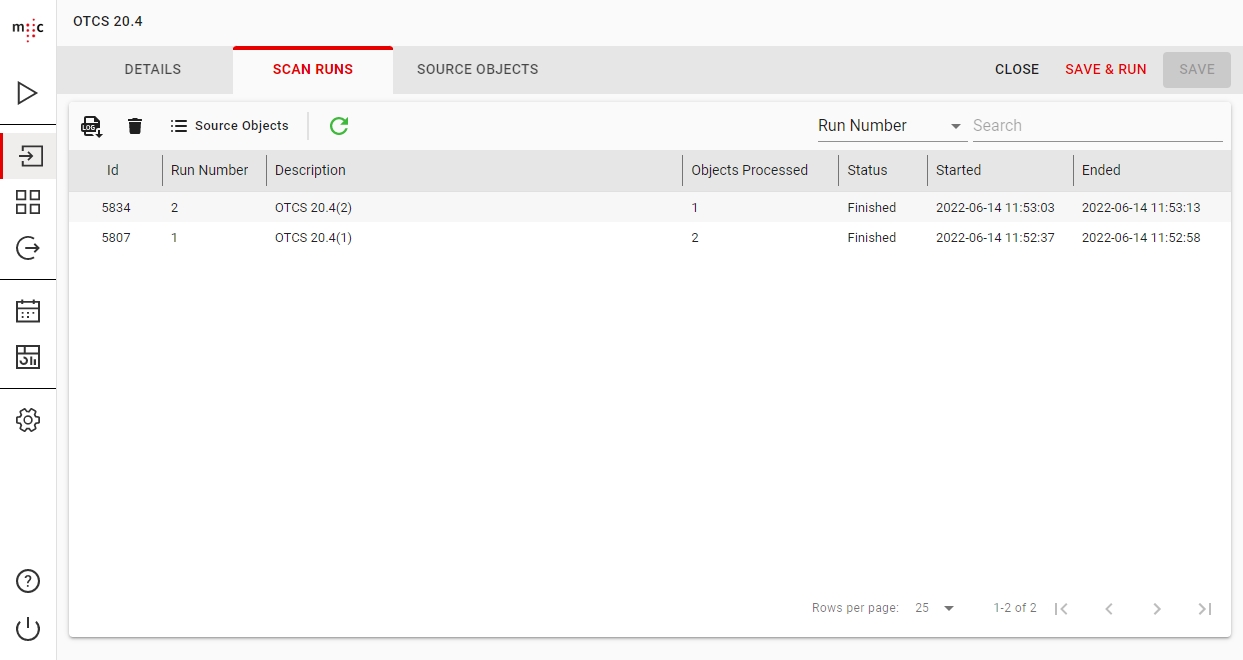
Version information of the migration-center Server Components the job was run with
The parameters the job was run with
Execution Summary that contains the total number of objects processed, the number of documents and folders scanned or imported, the count of warnings and errors that occurred during runtime.
Sign in
To connect to a migration-center database, open the WebClient URL address in the browser: https://<server-name>/mc-web-client/login
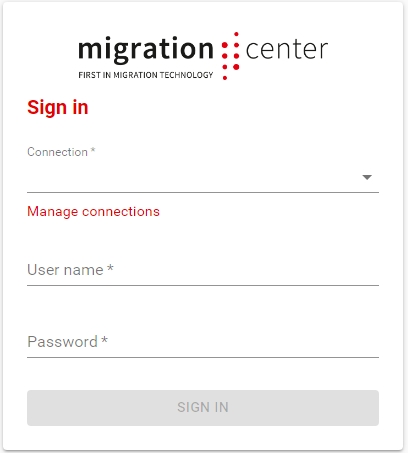
Connection Select one of the available connections to the server from the list. If no connections are available or if you want to modify an existing one, click Manage connections.
Manage connections You can create, modify and delete a connection and you can also refresh the list of existing connections.
To create a connection, click the Add Connection + button and then, in the New Database Connection dialog box, type your Connection Name, Database Type, Host, Port number and Service Name. When finished, click CREATE.
Return to the Sign in page either by double clicking the desired connection, by right-clicking the desired connection and selecting Log in using this connection or by clicking the Back < button on the buttons bar and then logging in.
User name Type your username (default fmemc).
Password Type your password (default migration123).
When finished, click SIGN IN.
Navigate the WebClient
You can easily navigate through the migration-center WebClient sections using the sidebar on the left, as follows:
Jobs
Start, stop or pause running jobs. This section also displays running scan and import jobs. Along with the description, the run number, start/end date.
Scanners
Create and configure scanners that connect to a source systems and extract documents and metadata as migration-center objects.
MigSets
Split the scanned objects into migration sets and define all the transformation rules and generate the target objects ready for import.
Importers
Create and configure importers that take migration sets with validated objects and imports them in a target system.
Schedulers
Create schedulers that run automated end to end migrations at regular intervals.
Dashboard
View graphs and analyze the status of the entire migration.
Configure
Create and manage Job Server definitions, Object Types and Mapping Lists. You can also renew your license and view information in the About section.
Help
Go to the documentation page relevant to the section you are currently in.
Log out
Disconnect from the current migration-center database.
Use the WebClient
To run a migration, first you need to create a Job Server definition. You can do so in the Jobservers section.
Then, you need to:
Additionally, you can:
Jobs
If the Jobserver is restarted while a job is running or paused, the job run will still be marked as such in the database, but it will no longer exist in the Jobserver. To restart the job you just need to Stop it first and start it again from the WebClient.
Scanners
You need to create, configure and run a scanner in order to connect to a source system.
Deleting a Scanner will also delete and remove all its associated Source Objects from the migration-center database.
Details
In the DETAILS tab, give your scanner a meaningful Name, then select the Type of connector from the list. Then, depending on the selected connector type, the Parameters section will be populated with the connector's specific configuration parameters.
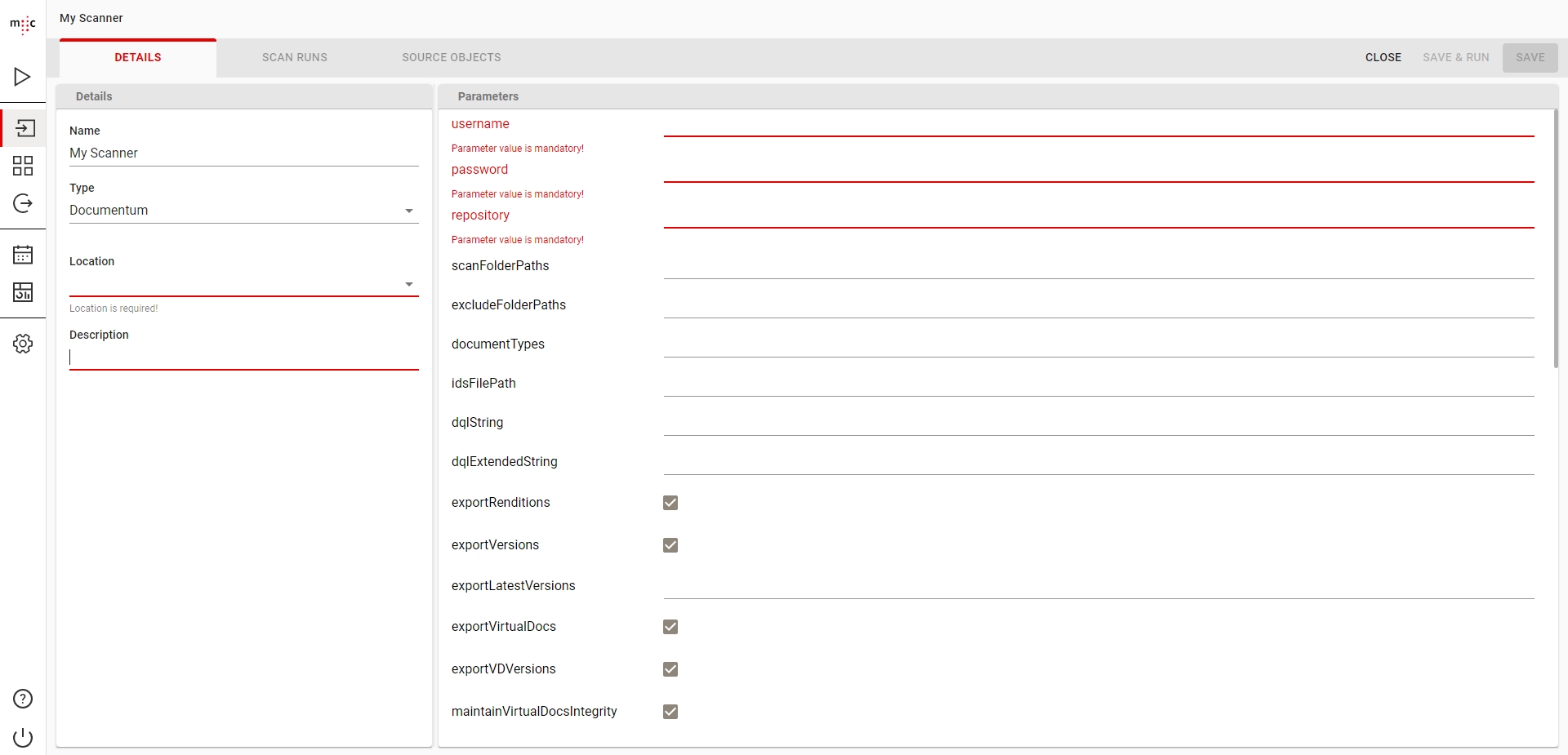
Next, in the Location field, select the Job Server where your Scanner be executed when you run it. Optionally type a meaningful Description for your scanner.
When finished, click either:
SAVE - if you plan to run the scan later;
SAVE & RUN - to save and run the scanner immediately, in which case you will be prompted to enter a description for this run in the Enter Job Run Description dialog box. By default the run description is the name of the scanner and the number of which run it is.
Scan Runs
To view the history of your scanner, click the SCAN RUNS tab of a scanner.
To view a Scan Run Log select the desired scan run and either right-click it and select Download Scan Run Logs, or on the Log icon ![]() in the toolbar or by double clicking the entry.
in the toolbar or by double clicking the entry.
When you delete a scan run, all the objects belonging to that run will be deleted and removed from the migration-center database.
Source Objects
You can view the metadata of the extracted documents for the entire scanner by clicking the SOURCE OBJECTS tab.
The first columns from Id to Import date are internal migration-center columns and the rest represent an attribute from your source system.
You can change the number of rows on a page and navigate between pages using the bottom toolbar.
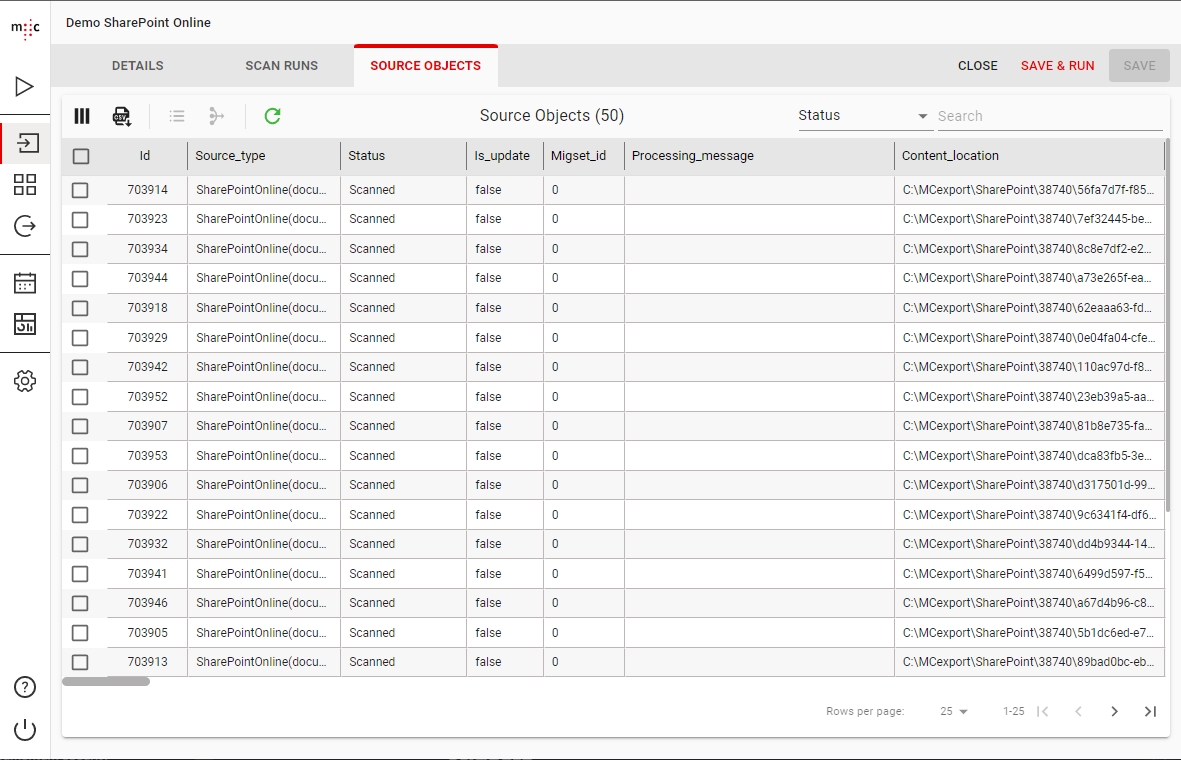
To Filter objects based on a specific attribute, use the dropdown to the right of the toolbar. This will enable you to select one of the attributes of your objects and then search for values in that attribute.
The Filter on the Object Tables is different than the ones in the main tables. Here the search is done in the database and it uses exact match.
You can use the following wildcards on the object table filters:
% (percent symbol) - match any number of characters
_ (underscore) - match a single character
Migsets
A migration set, or migset for short, is a grouping of Source Objects on which a set of transformation rules are applied which generates Target Objects.
Resetting imported objects will break the ability to do Delta Migrations for those objects in the future (scanning and importing updates to the already migrated objects).
Therefore this is NOT recommended unless you plan on deleting them from the Target System and re-importing them.
Properties
Details
In the PROPERTIES tab, in the DETAILS subtab, give your MigSet a meaningful Name and optionally a Description.
In the Type dropdown, select the Source to Target system migset type (i.e. FileSystemToDCTM). Once selected, the list of all scan runs that match the Source part of the migset type are displayed under the Available list.

You can also filter which objects are included in the MigSet by using the EXCLUSIONS and the ADVANCED FILTERS subtabs.
Exclusions
In the EXCLUSIONS subtab, objects are excluded from your MigSet by choosing which attribute values should be excluded. To do so, select the desired attribute under Available attributes and use the < > arrow buttons to exclude the values.
Advanced Filters
In the ADVANCED FILTERS subtab, you can create rule based filters using operators. Select a Source Attribute, Operator, Values and Connector, the click on ADD to include them. You can also delete rule filters.
You can check your selection by going to the OBJECT PREVIEW subtab.
Object Preview
In the OBJECT PREVIEW subtab, you can see a preview of the filtered objects.
When finished, click the LOCK OBJECTS button to add the selected objects to your MigSet. This means that these objects will be locked in this migset and cannot be used in another one. Then, in the Confirm Object Selection dialog box, click Yes.
Transformation
Rules
Transformation Rules define how metadata from Source Objects is used to generate new metadata for Target Objects by using Transformation Functions. A transformation rule is equivalent to a Target Attribute after transformation.
Rule Snippets
Snippet Rules are rules whose value can be used as a step in any other normal rule.
To set a Rule as a Snippet check Snippet checkbox ![]() in the Rule Properies.
in the Rule Properies.
To use a Rule Snippet insert a GetSnippetRuleValue function and enter the name of the Snippet Rule you want to use.
Snippet rules cannot use the GetSnippetRuleValue function.
Transformation Functions
A transformation rule can have multiple transformation functions. They can take source attributes, static strings or even previous functions as the input value and provide an output value.
See TR Function Reference page for a list of all available functions.
To add a Transformation Function:
Select the Transformation Rule you want to add a function to.
Under Transformation Methods, select the desired transformation Function you want to use and click on INSERT FUNCTION.
Fill the function parameters in the popup (the parameters vary depending on the function).
Click OK to insert the function or CANCEL to close the popup.
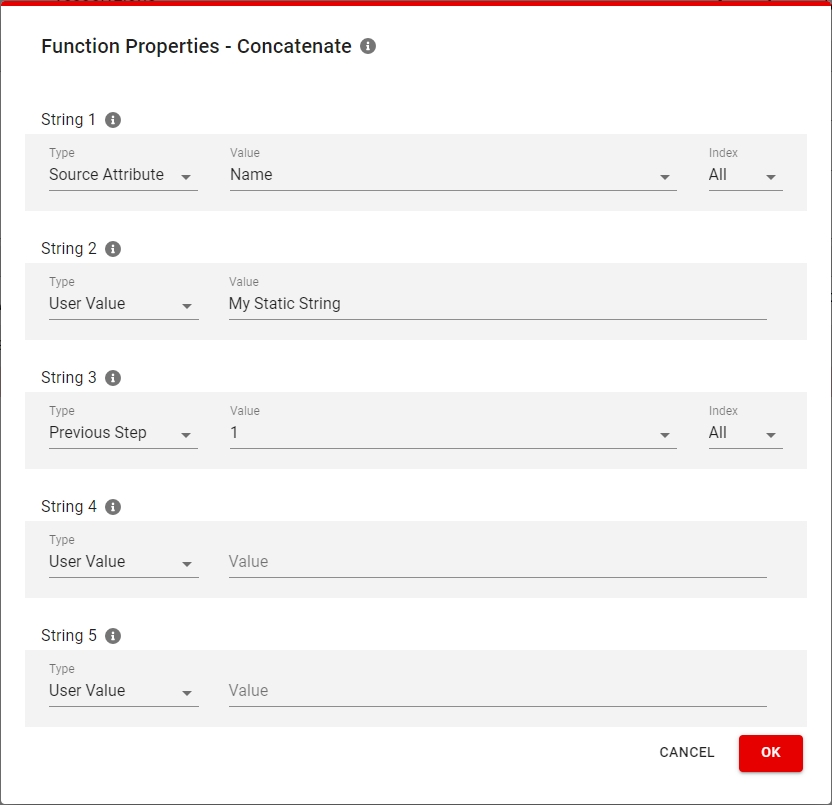

Multi-value Transformation Rules
Attributes from a source object can be Single Value or Multi Value (Repeating). A Transformation Rule can process both these kinds of attributes, but if the rule itself is not marked as MultiValue using the checkbox in the Rule Properties it will return only the last processed value.
A transformation function can process All values or only the value at a specific index of a repeating attribute.

After making a Transformation Rule into a multi value one, you can also return multiple functions as separate repeating values using the Result toggle.
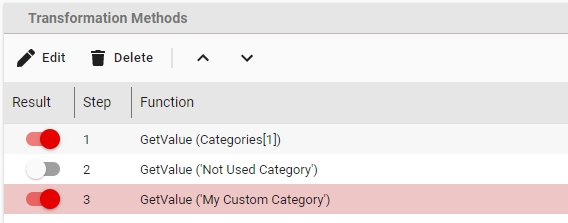
Debug Rule
A transformation rule can be debugged by taking a sample source object and us its metadata to see the results of each step in the rule.
Get the ID of an object whose metadata will be used for debugging the rule.
Select the rule you wish to debug.
Enter the Object ID in the text field next to the DEBUG RULE button.
Click the DEBUG RULE button.
The value for each step is calculated based on the metadata of the selected object and displayed in the Debug Values column.

Double clicking on the Debug Value of a step opens the value in a dialog window for better viewing.
Debug values does not take into account if your rule is single or multivalue.
Ex: in a single value rule, repeating values will be displayed at the last step when using Debug, but only the first value of the repeating values will end up in the transformation.
Generate Rules
Using the generate rules feature will delete any existing transformation rules and changes will be saved automatically after the confirmation dialog.
Other Features
You can also Transform or Reset the objects of this migset without returning to the list of migsets.
Limitation: If you import new rules into a Migset that already has transformed objects, the attribute names and values will not be displayed correctly in the Objects views.
You need to reset and transform the objects again to get the new metadata displayed correctly.
Migset Mapping Lists
The migset mapping lists function in the same way as regular mapping lists except they are usable only in the migset they belong to.
Fore more details please see the main Mapping Lists section.
Associations
Transformation Rules are not automatically used when importing an object. They need to be associated to a Target Attribute of an Object Type in the Associations subtab of the migset.
Each Migset has a target type system rule that determines to which type an object will be associated with. This rule differs depending on the migset type. For example for any ...ToDCTM migset the rule is r_object_type.

Source Objects
You can view the source attributes of the objects in the MigSet by clicking the SOURCE OBJECTS tab.
The first columns from Id to Import date are internal migration-center columns and the rest represent an attribute from your source system.
You can change the number of rows on a page and navigate between pages using the bottom toolbar.
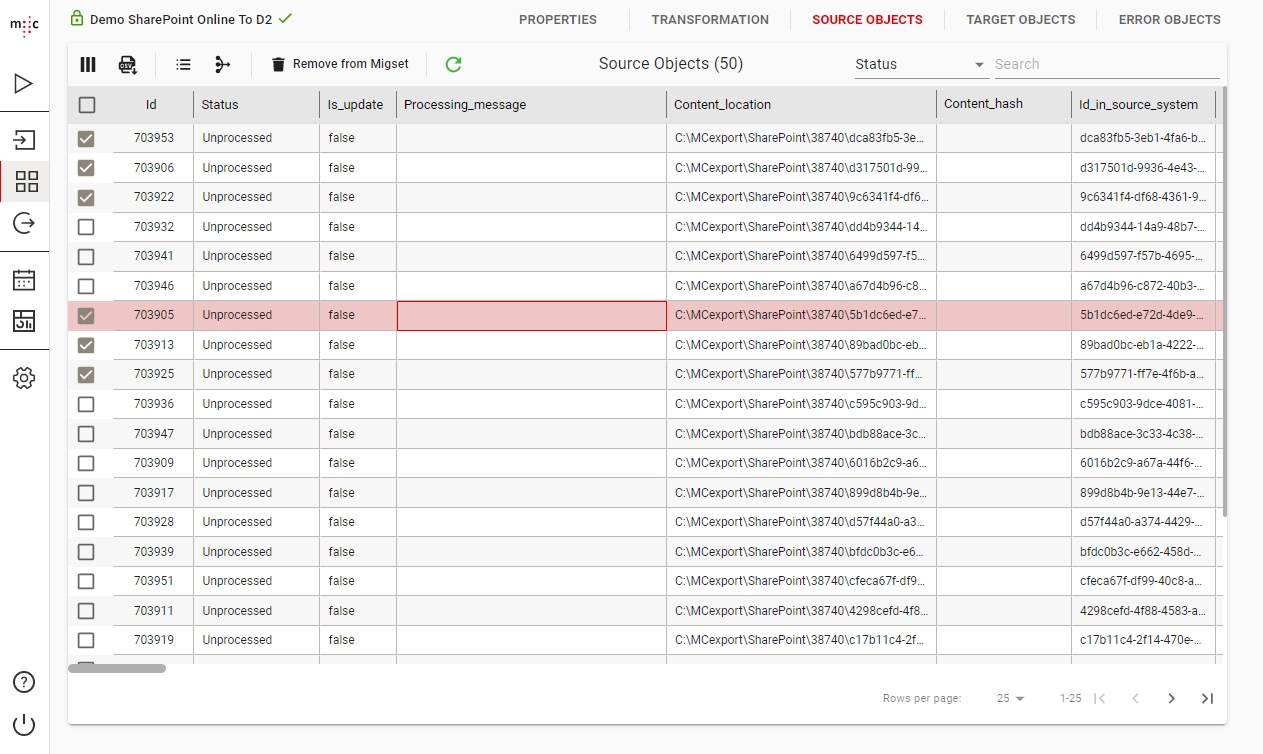
To filter objects based on a specific attribute, use the dropdown to the right of the toolbar. This will enable you to select one of the attributes of your objects and then search for values in that attribute.
The Filter on the Object Tables is different than the ones in the main tables. Here the search is done in the database and it uses exact match.
You can use the following wildcards on the object table filters:
% (percent symbol) - match any number of characters
_ (underscore) - match a single character
Target Objects
You can view the attributes generated by the transformation rules of the objects in the Migset by clicking the TARGET OBJECTS tab.
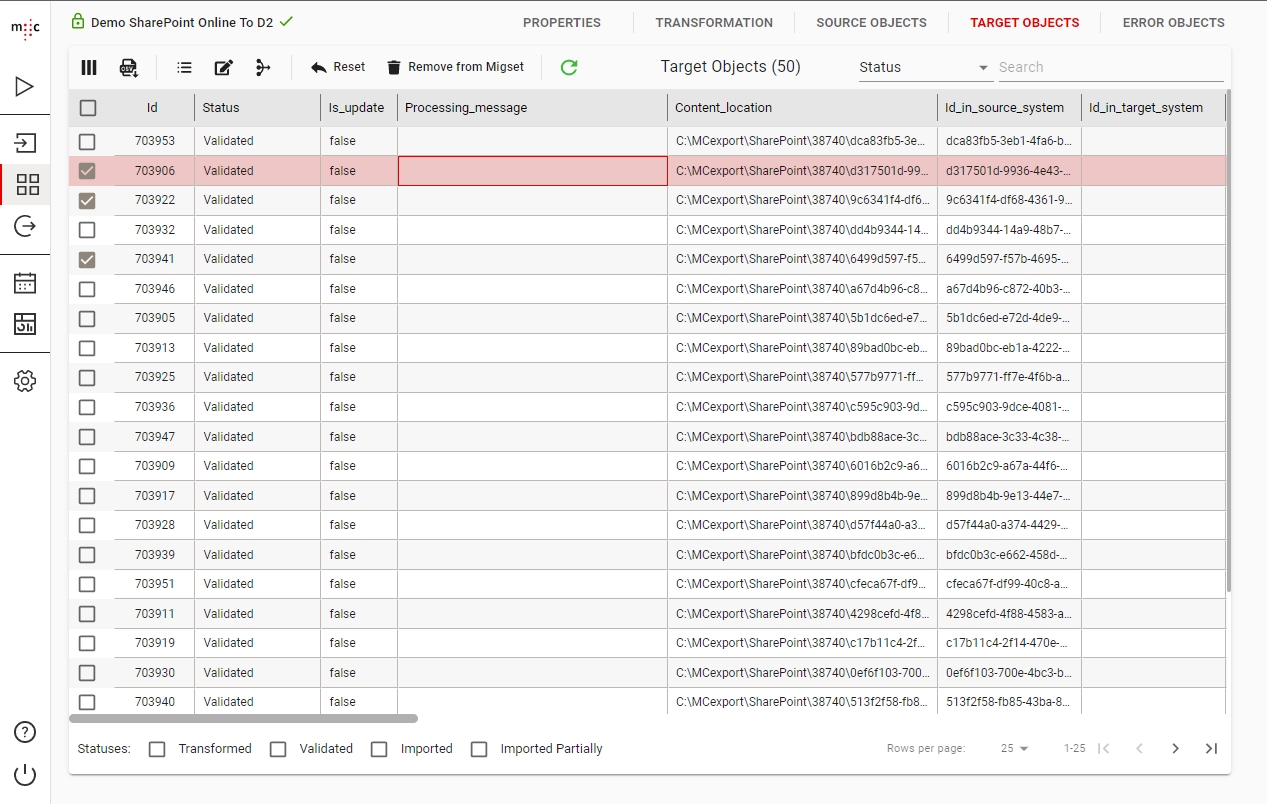
Please see the Source Objects section for features common to all Objects Views, including Target Objects.
To Filter objects based on their status, use the Statuses checkboxes in the bottom toolbar.
Error Objects
You can view the objects that encountered errors during the Transform, Validate or Import phases in the MigSet by clicking the ERROR OBJECTS tab.
The Error Objects tab has features present in the Source Objects and Target Objects tab.
Importers
Importers will connect to the Target System, take the selected MigSet with Validated Objects and import them. You can monitor the progress in the Importer run history or directly in the MigSets view.
Details
In the DETAILS tab, give your Importer a meaningful Name, type or select the Importer Type from the list and complete the needed Parameters.
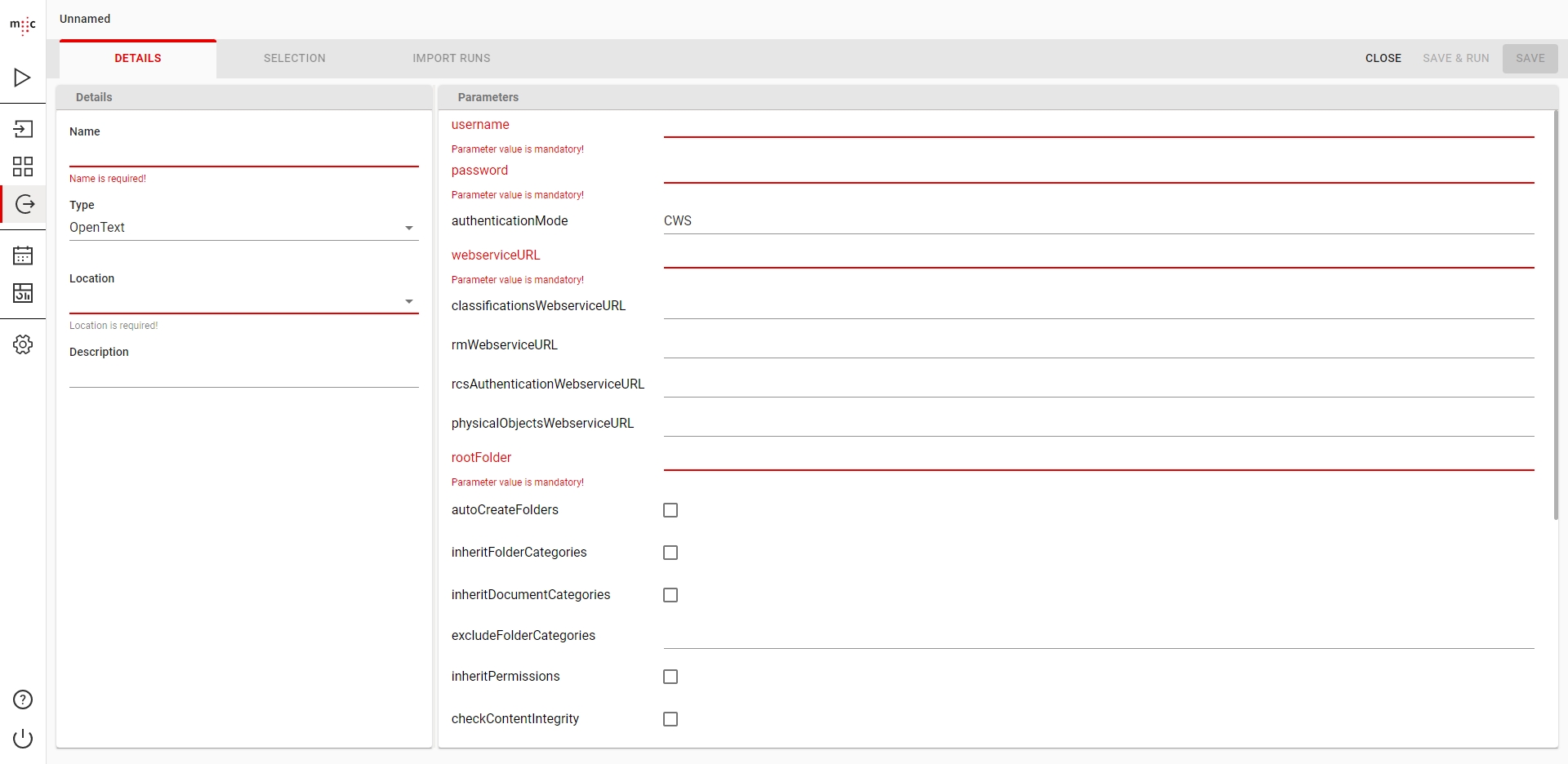
Next, in the Location field, select the Job Server where your Importer be executed when you run it. Optionally type a meaningful Description for your scanner.
Migset Selection
In the SELECTION tab, under AVAILABLE MIGSETS you can see MigSets with validated objects that match your target destination: for example, for an OpenText importer, only MigSets with the type ...ToOpenText will be displayed. Double-click the desired MigSet to add it to the ASSIGNED MIGSETS list to be migrated. Note that only validated objects or error objects that previously failed an import will be processed.
When finished, click either:
SAVE - if you plan to run the import later;
SAVE & RUN - to save and run the import immediately, in which case you will be prompted to enter a description for this run in the Enter Job Run Description dialog box. By default the run description is the name of the importer and the number of which run it is.
Import Runs
To view the history of your importer, click the IMPORT RUNS tab of an importer.
Delta Migration
Delta Migration is a feature of migration-center that allows you to migrate updates made to documents that have already been scanned and newly created documents that were not scanned yet.
This feature is possible using most available connectors.
Check the user guide for your connector to confirm if it is capable of delta migration and to see if there are any pre-requisites or limitations.
Prerequisites
You need to have the initial batch of objects scanned, transformed and imported successfully. In the target system the imported objects need to be present.
The original MigSet/s must not be changed by resetting or unlocking the objects or by deleting the MigSet. If this happens, update objects cannot be imported.
Scanning
You can start a delta migration by running either the same original scanner or any scanner that will pick up already scanned objects. If these objects have been modified since the original scan, they will be scanned again as an update object, otherwise they will be ignored. New objects, that were not scanned before will be scanned normally.
Update objects can be identified by having the is_update attribute value set to 1 or True.
MigSet
Since the original MigSet needs to be left untouched with all objects intact, and the delta migset needs the same rules, the best way to do this is to create a copy of the original migset.
Transform the migset used for the Delta Migration, as you would normally.
Importing
The Delta MigSet can be selected in the same Importer used for the original import, or in any other importer as required.
The Delta Import will create all new objects normally and it will locate already imported objects in the target system and update their metadata and content as needed.
Schedulers
The Scheduler feature only works with migration-center running on an Oracle database.
A Scheduler is used to automate an end to end migration and is useful when needing to make regular delta scans and imports for a Source System that changes often.
The workflow of a Scheduler is as follows:
It will run the selected Scanner
If there are objects in the Scan Run, it will create a copy of the selected Migset, assign the Scan Run to it and Transform the objects
If there are Validated Objects after the transformation, it will assign the migset to the Importer and run it.
If Email Report is set it will send the email as configured, when the import ends.
To run a Scheduler the Database Server also needs to access the Jobserver configured for the Scanner and Importer on the selected Port. The reason being that the Oracle Database will start the jobs directly.
Configuration
In the CONFIGURATION tab, configure the Details of your scanner, such as Name, Description and whether you want to set the scheduler to Active.
Next, select the Scanner, MigSet and Importer by clicking the respective buttons. The list of Migsets will be filtered to match the selected Scanner type and the list of Importers will be filtered to match the selected Migset type.
Frequency
In the FREQUENCY tab, configure the Start Date when this scheduler will be running from and either the End Date or the number of runs after which it will stop.
In the Interval section configure a timeslot and the Frequency at which the Scheduler will start.
In the Email Report section you can set an Email Address where the scheduler will send reports and whether you want the report send in case of Success or in case of Error. You also need to have an SMTP Server to use for sending the email reports.
In the IMPORTED OBJECTS tab, you can see the list of objects imported by your scheduler.
In the ERROR OBJECTS tab, you can see the list of errors that may have occurred during the scheduled migration. When finished, click Save on the top right corner.
History
In the HISTORY tab, you can see all the runs of the selected Scheduler.
To view the Imported Objects or Error Objects, select a run and click on their respective icons.
Imported Objects
Here you can view the list of Imported Objects for the selected Scheduler Run.
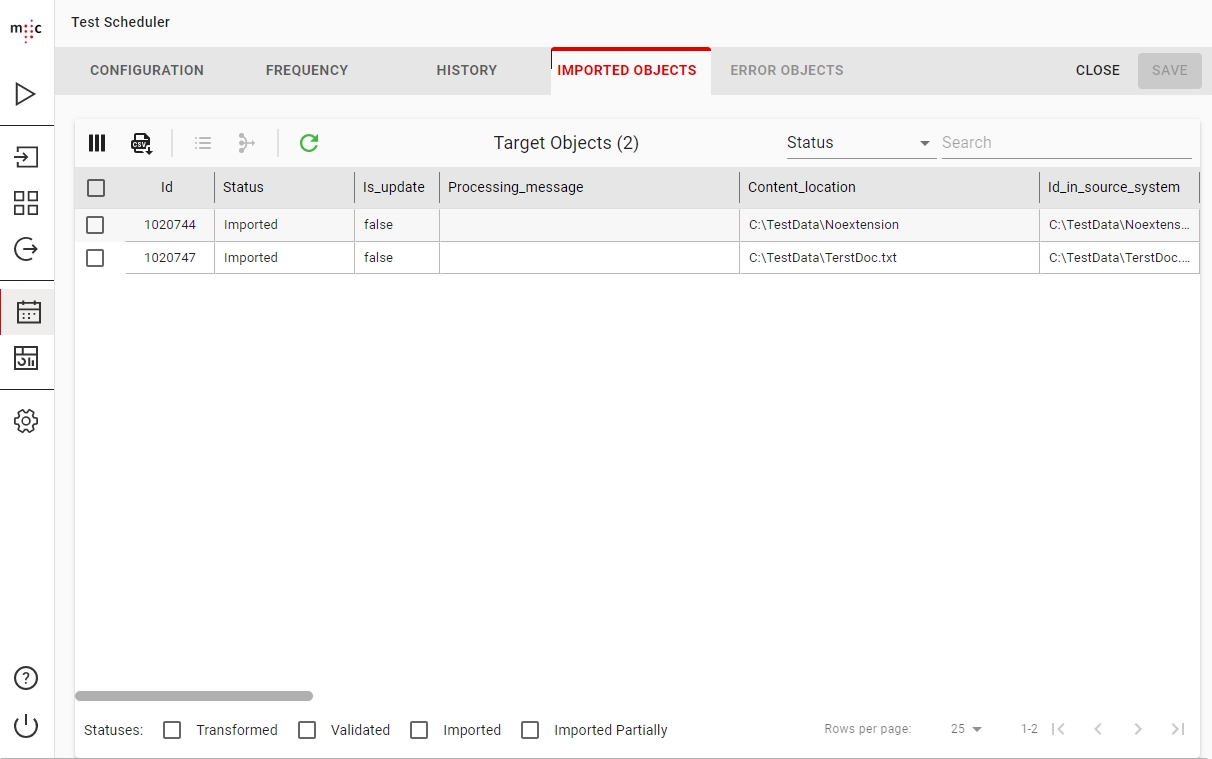
The Imported Objects view features are common among the other Object Views. Please see Source Objects for details.
Error Objects
Here you can view the list of Error Objects for the selected Scheduler Run.
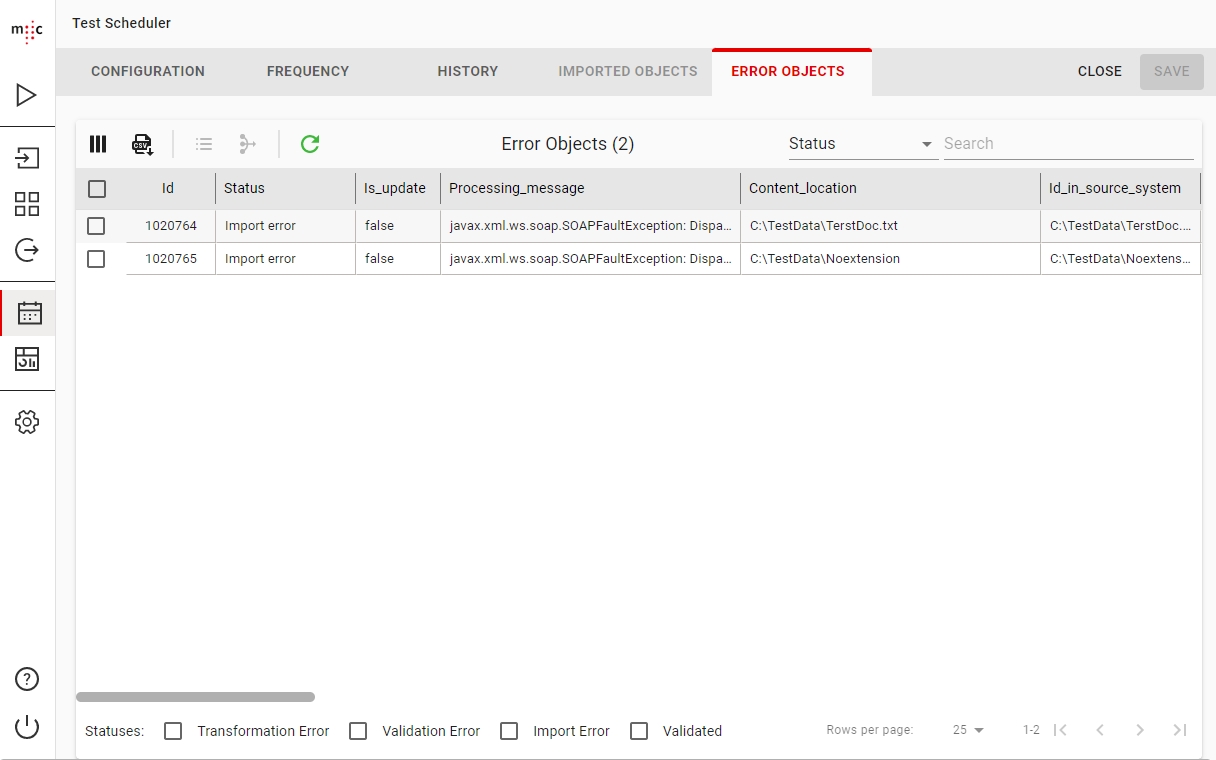
The Error Objects view features are common among the other Object Views. Please see Source Objects for details.
Dashboard
Migration Status
The Migration Status tab of the Dashboard presents the total number of objects in your Database, divided between the 4 states: Unprocessed, In Progress, Errors and Imported.

From the dropdown menu on the left you can chose to display Numbers or Percentages on your graph.
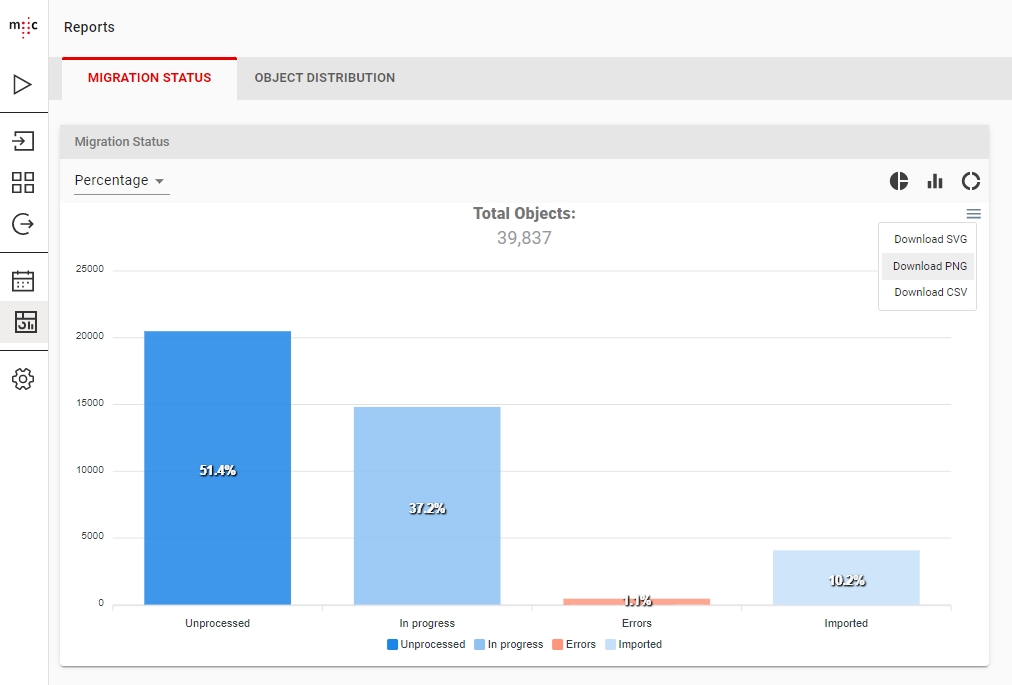
Object Distribution
The Object Distribution tab provides more detailed reporting for specific source object types or specific Scanners.
The chart on the left shows the scanned object distribution yearly, while the chart on the right shows the scanned objects distribution monthly for a selected year.
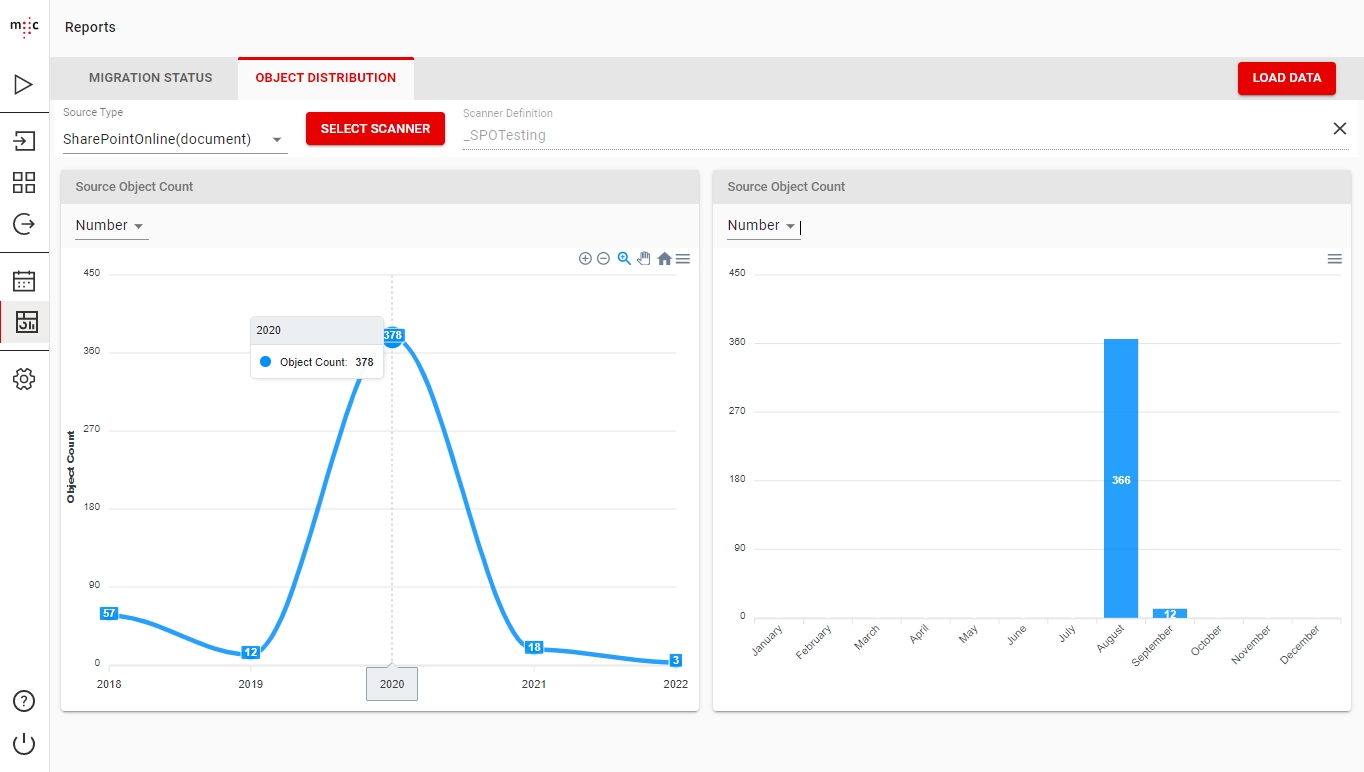
To load all data of a source object type, first selected the required type from the Source Type dropdown and then press Load Data.
To load the data of a specific scanner, after selecting the required Source Type, press the Select Scanner button.
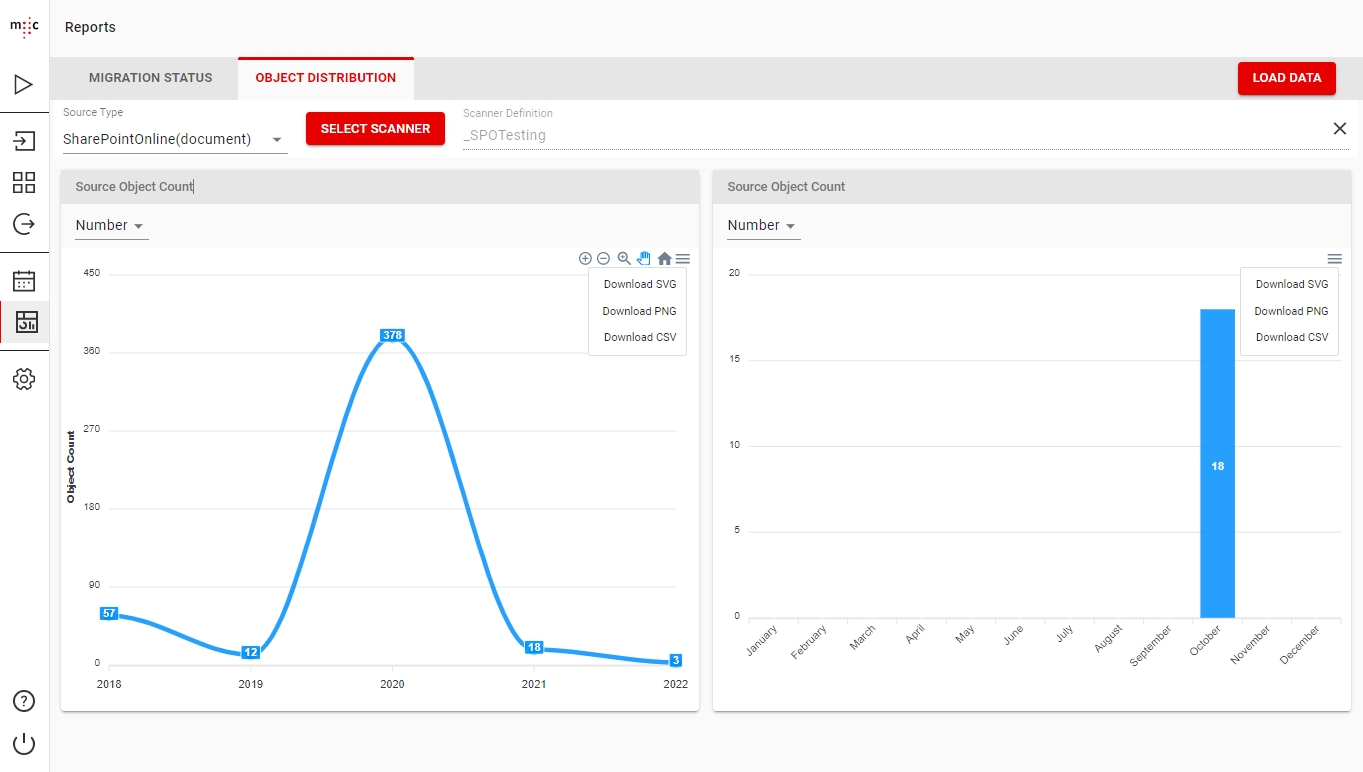
Object Search
You can search for any Source / Target Object in the Object Search section using values of Internal, Source or Target attributes.
Search criteria
When searching by Internal Attributes, you can select the Attribute name from a dropdown of predefined attributes. Afterwards enter the Value by which you want to search.
When searching by either Source Attributes or Target Attribtues you have to manually enter the Attribute Name. Afterwards enter the Value by which you want to search.
When searching by Target Attributes, you can only use the Target Object Type Name that a rule is associated to. You cannot seach by rules that are not associated to any target object.

Start the search by clicking the Search button.
Stop the search by clicking the Cancel button that appears when a search is in progress.
All searches are run in the background. You can leave the Object Search section after starting a search and return to at a later time to check if it's finished.
Search Results
When a search query finishes, results start loading in the Objects table.
You can nagivate to each of the Scanner, Scan Run, Migset, Importer and Import Run configurations that the object is contained in, by clicking on the ID value in the row of the object.
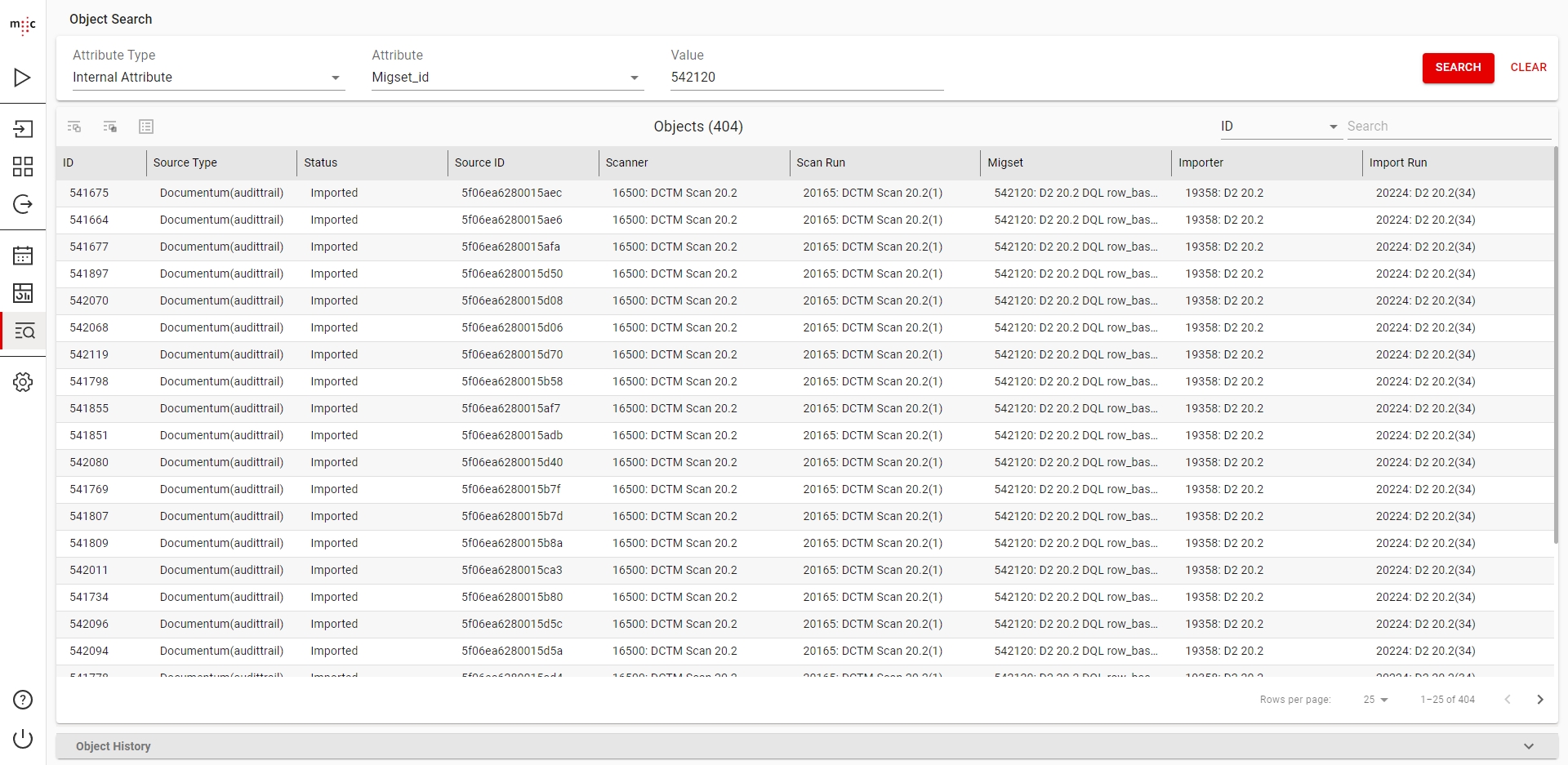
When viewing Target Attributes, only the ones that are associated to a Target Object Type will show up. To view all migset target attributes, go to the migset the object is in.
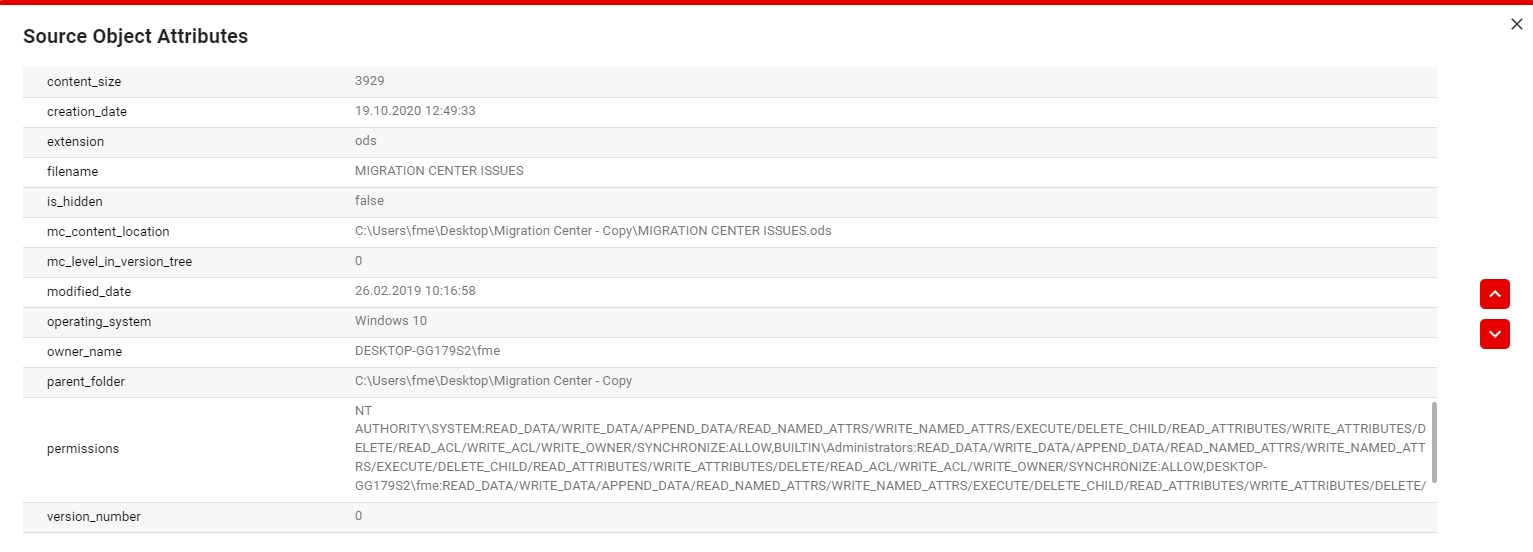
Object History
The Object History view is a list of all Scan or Import operations that an object has gone through, along with the the Job Run ID, Source ID and Target ID.
To open the view click on the collapsed header on the bottom of the screen. You can also resize it by dragging the space between the two tables.
To load the history of a specific object just select it in the results table.
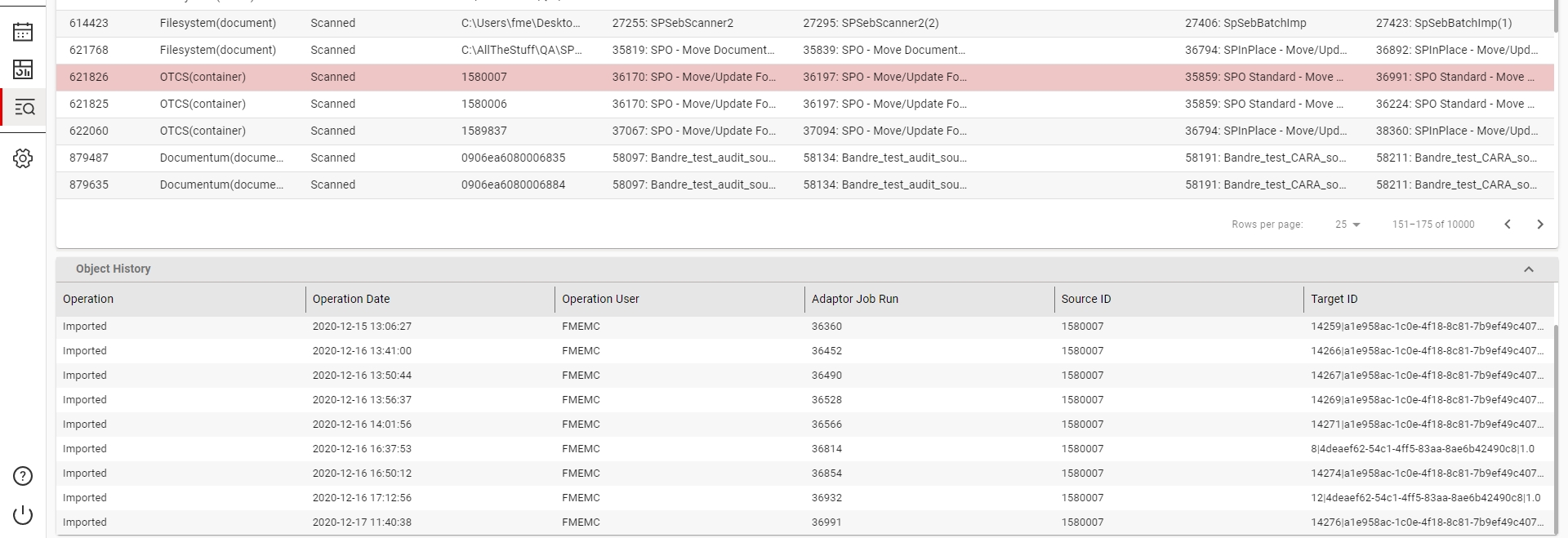
To view the History Attributes of a specific operation right click it and select the View History Attributes entry in the context menu. These attributes will be either Source or Target depending on the type of the operation.
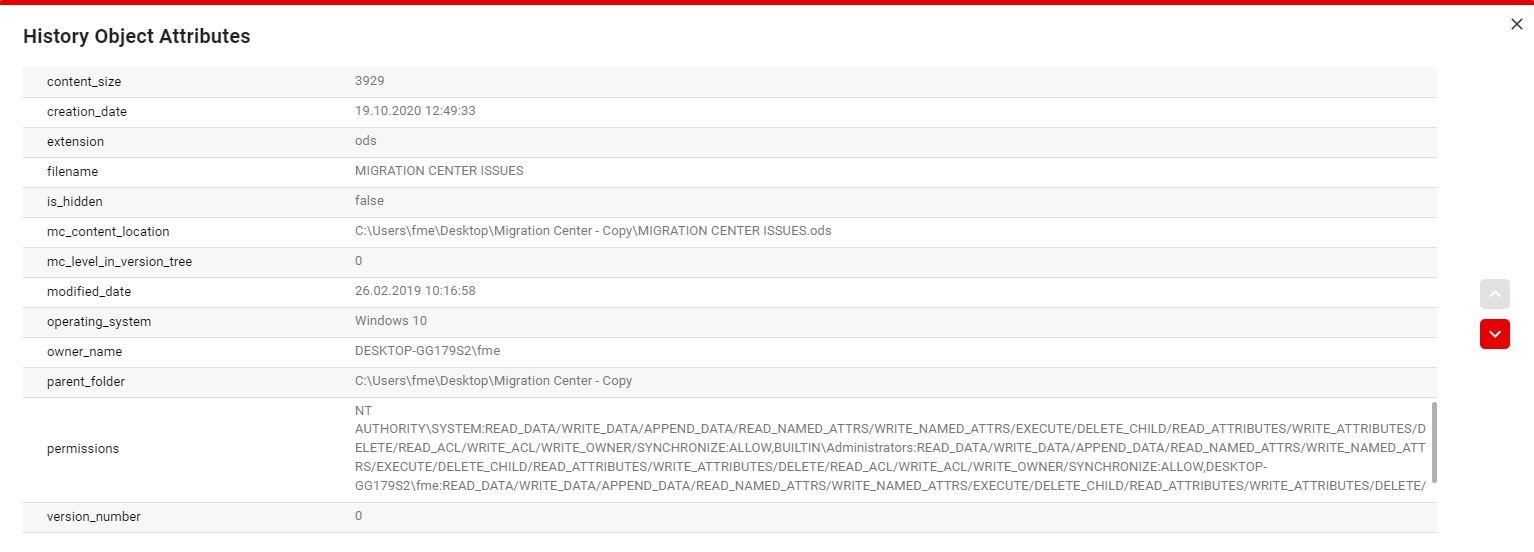
Configuration
Job Servers
A Job Server definition is needed to run jobs like scanning or importing documents.
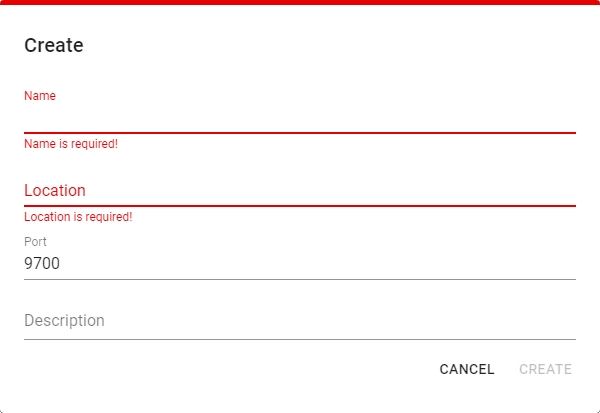
Enter a Name, Location (where a Job Server is installed), Port (9700 by default) and a Description (optional) for your Job Server definition. When finished, click CREATE.
Object Types
Object Types in migration-center are a representation of a document or other objects in a Target System where you are importing. They are used in the Associations section of a migset and any object needs to be associated to at lest one Object Type to be able to Transform, Validate and Import it.
Only CSV files using comma "," as separator are supported. See the CSV "RFC 4180" specification.
Adding attributes
The attributes of an object type need to match the attributes or fields in the target system in Name and Type. If the attributes do not accurately represent the target system this can result in object values passing validation and causing errors during the Import phase.
Mapping List
A Mapping List is a collection of key - value pairs that can be used in Transformation Rules using the MapValue() function.
Checking Exact Match makes the mapping list match key values only if they are exactly the same.
Using Exact Match unchecked will result in the mapValue and mutliColumnMapValue functions to match source strings that contain the key in the mapping list as a substring.
Partial matches do not work the other way around. A source string "sample" in a mapValue function will not match a mapping list key with the value "Test sample 1".
Checking Case Sensitive makes the mapping list match key values only if the case matches. Otherwise matches will be made regardless of case.
Adding entries
Only CSV files using comma "," as separator are supported. See the CSV "RFC 4180" specification.
To delete all entries select the mapping list and click on the Clear Values icon ![]() on the mapping list values toolbar. When finished click on SAVE.
on the mapping list values toolbar. When finished click on SAVE.
Multi Column Mapping Lists
The Multi Column Mapping List is a new feature usable only with the migration-center WebClient.
Using a Mapping List
To use a regular Mapping List, in the transformation rule select the MapValue() function. Set the value to be matched with the values in the Key column, select the Mapping List you want to use and whether or not you want the function to report a transformation error when a value is not matched.
To use a Multi Column Mapping List, in the transformation rule select the MultiColumnMapValue() function. Set the first parameters as you would for a regular mapping list and also specify the name of which Value column you want the function to return when finding a match.
Licence
Here you can enter a new License key for the migration-center database installation you are currently connected to.
Entering a license key with different migration paths, will NOT update the list of available Connector or Migset types.
About
The About section provide information on your current installation as follows:
Version of migration-center components: UI version, API version and Database version.
The Java version that is running the WebClient Apache Tomcat.
The Oracle version of the migration-center Database that you are currently connected to.
Licence Information: Licensed to and Licence validity.
Last updated
Was this helpful?
